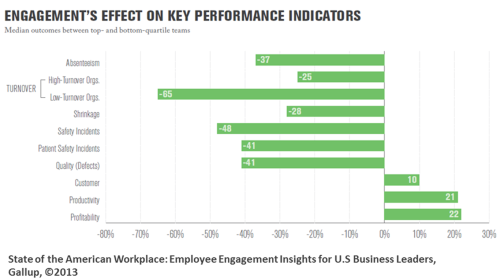I was talking with the CEO and CMO of a startup software company in the HCM space yesterday. One of the things we talked about was the ready availability of data that link organizational performance with employee engagement.
No longer the stuff of smoke and mirrors, the correlation between higher revenue, lower costs and greater customer satisfaction with employee engagement is rock solid.
Whether the data come from academic researchers, think tanks, research/analysis firms or other interested parties, we can cite legitimate sources to underpin our ROI calculations. (See my previous posts here and here.)
Why pushing engagement really matters
Gallup’s recently released State of the American Workforce is one example of such data. In the “From the CEO” introduction, Gallup Chairman and CEO Jim Clifton says:
Here’s what you need to know: Gallup research has found that the top 25 percent of teams – the best managed – versus the bottom 25 percent in any workplace – the worst managed – have nearly 50 percent fewer accidents and have 41 percent fewer quality defects. What’s more, teams in the top 25 percent versus the bottom 25 percent incur far less in health care costs. So having too few engaged employees means our workplaces are less safe, employees have more quality defects, and disengagement – which results from terrible managers – is driving up the country’s health care costs.”
Here’s the corresponding chart from the report:
A clear relationship between engagement and performance
You may or may not have an opinion about Gallup’s Q12 methodology, but the longitudinal nature of their data — together with their periodic meta-analysis — says to me that their findings have weight. We can take to the bank – and to our CEOs and CFOs – the relationship between higher engagement and stronger organizational performance.
This is the data of sound and persuasive business cases for investing in the well-being of our employees. Take a look at the Gallup findings. You’ll find something that will spark an ah-ha moment.
Or maybe two or three.
This originally appeared on China Gorman’s blog at ChinaGorman.com.
